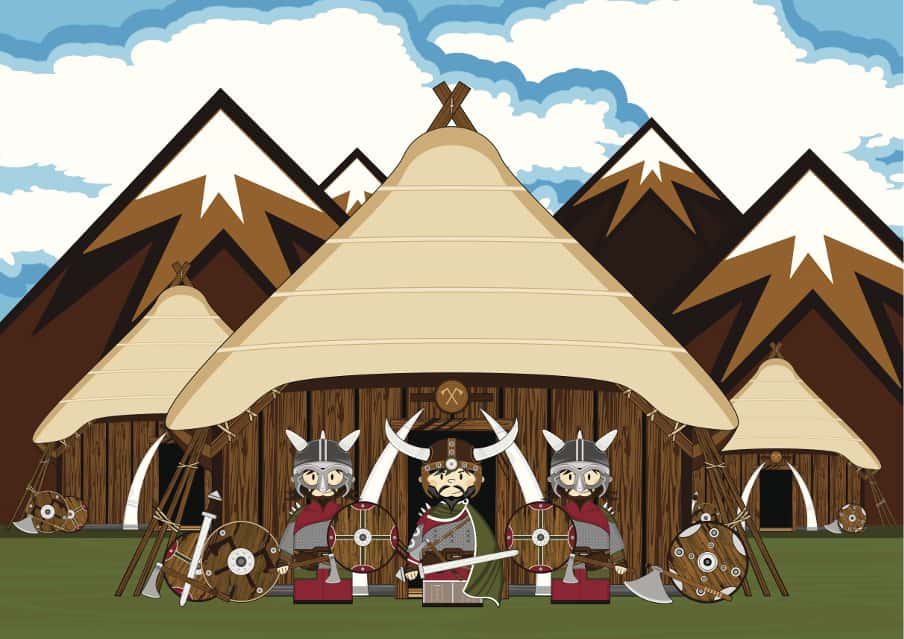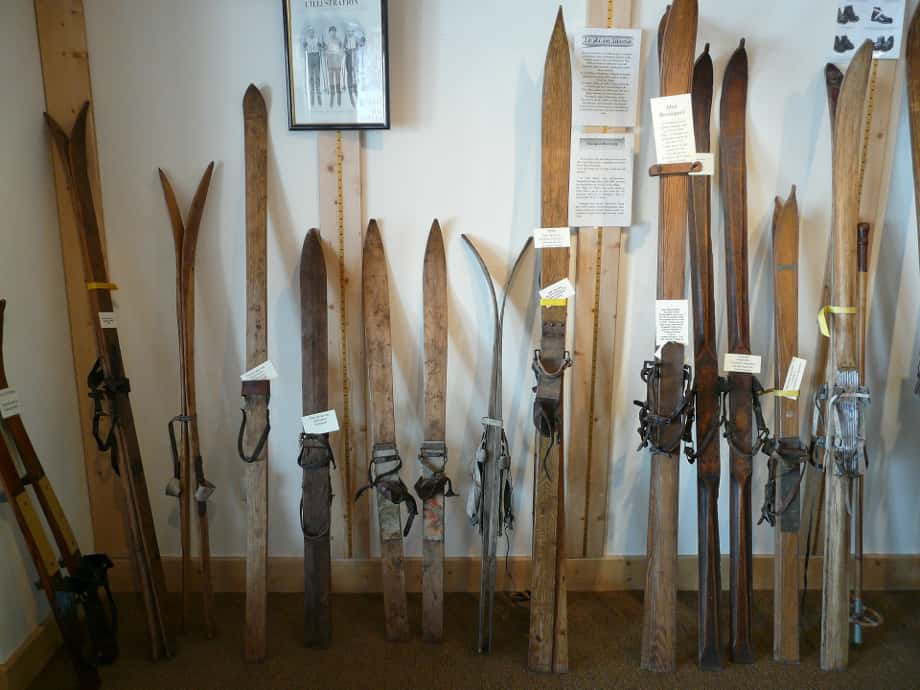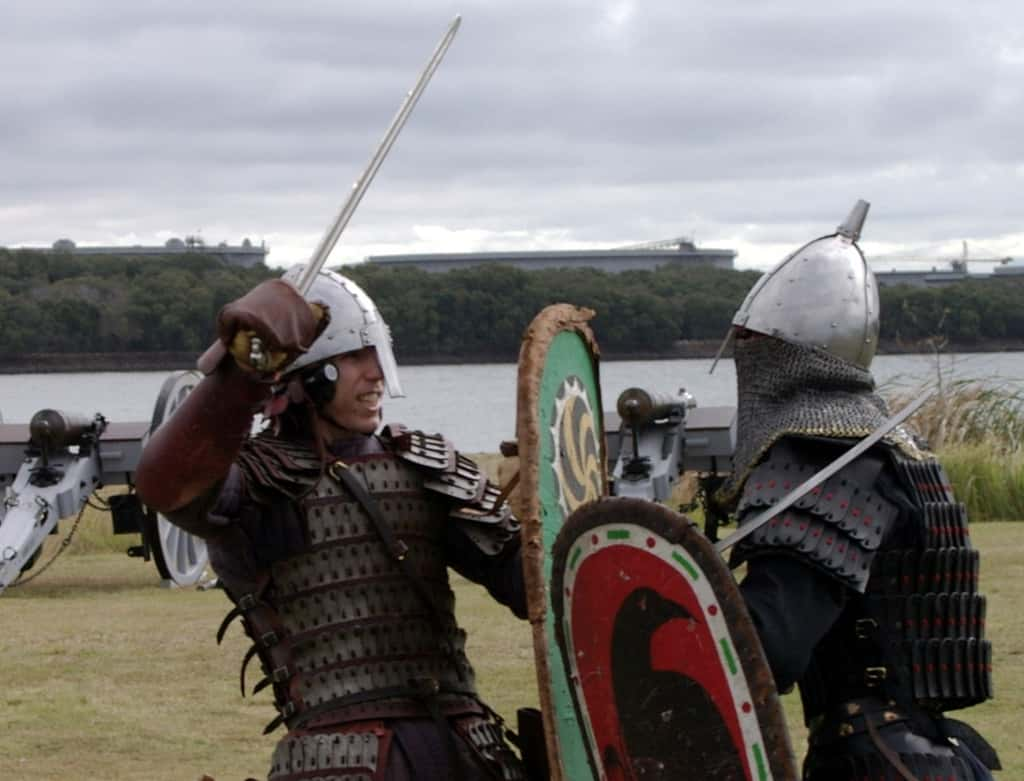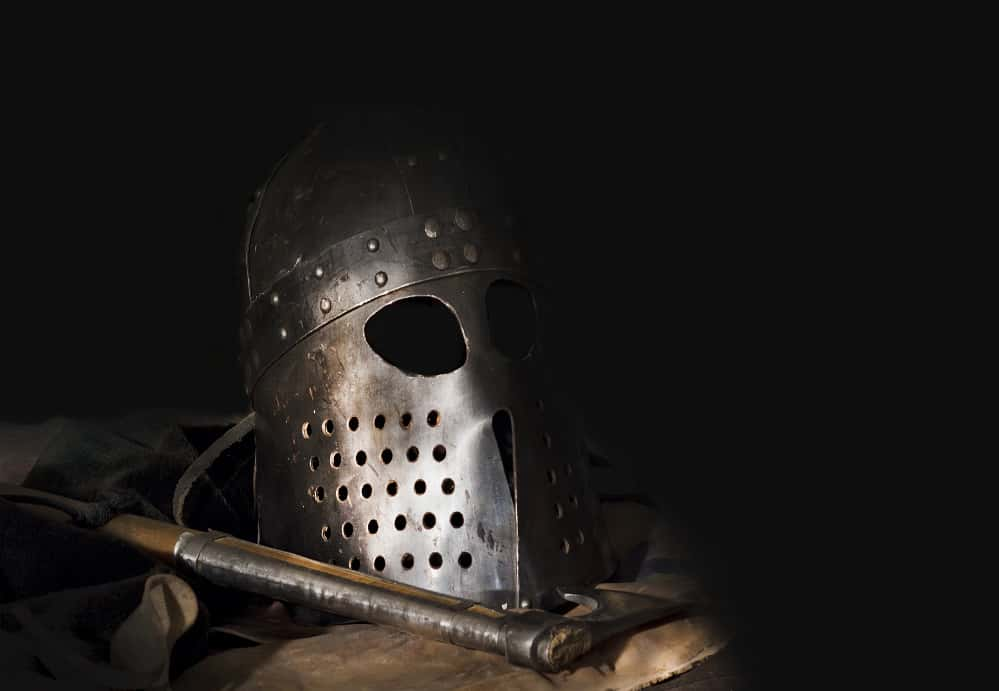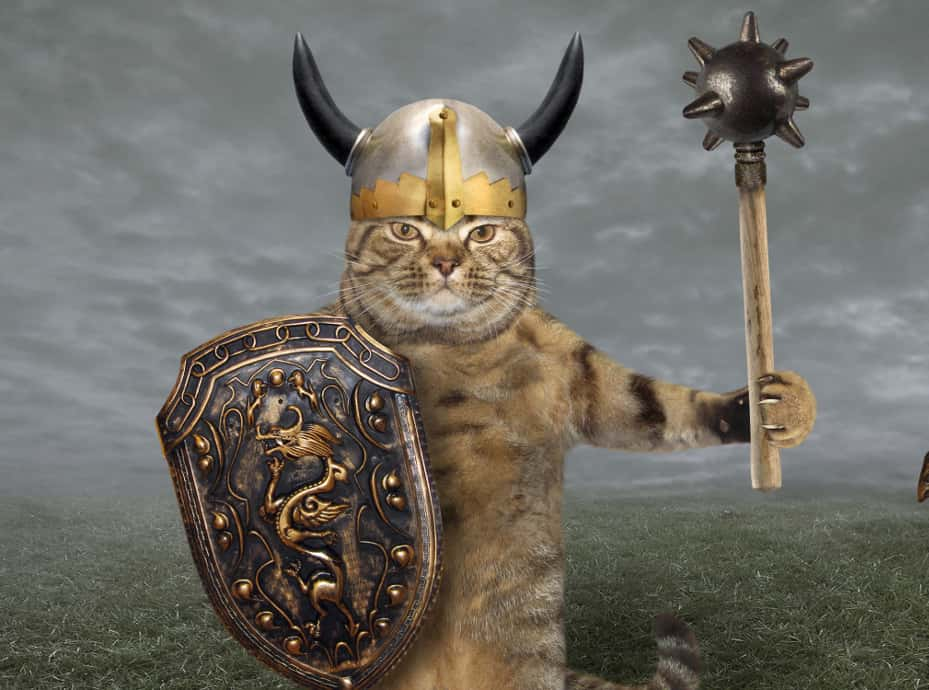Did the Vikings do anything other than raid and pillage?
While it’s true that some Vikings were raiders, they were just one small part of Norse society. The vast majority of Norse men and women peacefully grew things like barley, rye, or oats and some raised animals.
Which of the following words have a Viking origin?
The Vikings left their mark all across Europe, and this can be seen in the way they affected many languages. In English, not just anger, hell and freckles come from the Vikings, but also ugly, weak, skull, slaughter, cake, husband and wife, among many others.
Did Vikings actually wear horned helmets into battle?
While one very ancient horned Viking helmet has been found, it was ceremonial and wasn’t used for battle. Actual Viking battle helmets were completely hornless—the image of the horns was first used in a German musical drama in 1876, and it just stuck.
What would Viking parents do with weak or sickly children?
The warlike Vikings could be extremely unsentimental with their newborns. If they thought a child would not grow up strong and fierce, they didn’t even bother raising it.
Why did Christian monks and priests think the Vikings were invading?
Viking raids were so brutal and terrifying that the monks and priests of the British Isles assumed that the only possible explanation for them was that God had sent these beasts to punish Christians for their sins.
What were the major social classes in Viking Society?
The King was the highest in Viking society, followed by his nobles, called the Jarls. The Karls were most of the population, consisting of free citizens, usually farmers, tradesmen and builders, and the Thralls were the slave class.
Where do we get most of our information about the Vikings?
The Vikings didn’t keep good records of their history, so a lot of what is known about them was written by the various peoples that they invaded. Seeing as those people had little fondness for the Vikings, this is a large part of why most people think of the Norsemen as mindless barbarians today.
Which of the following Irish cities were originally Viking settlements?
During the Viking Age, the Vikings set up shop all across the coasts of Europe, and many cities, not just in Ireland but all over the continent, were either founded or expanded as Viking settlements.
What was the name for the terrifying Viking warriors who would go into battle in a trance-like state of fury?
The word “berserk” comes from these formidable soldiers who would often wear bear and wolf skins into battle, eschewing regular armor.
What were the roofs of Viking homes made of?
Viking sod roofs would help insulate their houses and applied pressure to the walls, ensuring they kept the wind out. Plus, they looked so pretty!
What was the name for the large Viking ships used to travel the open ocean?
Ships were an extremely important part of Viking culture, and they had many different kinds. While most of their ships were mostly used to raid along the coasts, the knarr were much larger, and these were what was used to colonize places like Iceland, Greenland and North America.
Who was the first European to discover the Americas?
Around 500 years before Columbus sailed the ocean blue, a group of Vikings led by Leif Erikson landed on the northeast coast of Canada, naming it Vinland. Though they never managed a permanent foothold, some of their settlements have been found, such as at L’Anse Aux Meadows in Newfoundland.
Why do we associated Vikings with blonde hair?
Blondeness was very common in Scandinavia, but part of the reason that so many people associate blonde hair with the Vikings is that many of them would bleach their hair (and even their beards) blonde to kill lice.
Where does the word “Viking” come from?
Most of the people whom we call "Vikings" wouldn't have called themselves that. The term vikingar, which means "raider" or “pirate," would only have referred to those Scandinavians who took part in pillaging voyages during the 8th-11th centuries. But since the people who wrote about them only came into contact with the invaders, that’s the name that got used for the whole culture.
What did the Vikings use skis for?
The Scandinavians invented simple skis at least 6,000 years ago, and kept using them through the Viking Age. Norsemen saw skiing as an efficient way to get around, and they could be extremely useful during snowy, Scandinavian winters.
Where did Viking invaders hide their loot?
The Vikings hid vast hoards to protect the treasure that they looted from England and other countries. One of these hoards was discovered in 1862, and it contained a vast store of silver in the form of coins, ingots, and hacksilver.
What was a thrall?
Unsurprisingly, given their reputation, Vikings were very active in the slave trade. They would capture and enslave both women and men while raiding Anglo-Saxon, Celtic and Slavic areas. They called slaves “thralls,” and they sold them across Europe and the Middle East.
What culture allowed women to divorce their husbands and inherit property?
At least compared to other historical cultures, women were quite respected by the Vikings. They could also live and sleep with a man without marrying him.
How did Vikings make fire?
Hnjóskr or fnjóskr was a fungus that the Vikings cut into slices, beat flat, then soaked in urine. Sounds gross, but afterwards the material would smoulder for days at a time, making it extremely useful for starting fires.
What kinds of pets did the Vikings keep?
Vikings kept all kinds of pets, including bears! Brown bears were widely kept as pets but polar bears were considered to be for noblemen only. If a bear got loose or injured a person the owner could face stiff fines and penalties. Eventually, this practice was outlawed because the bears became a nuisance.
Where did Viking warriors hope to go when they died?
The Vikings believed that if they died in battle, they might be chosen to join the god Odin in the majestic halls of Valhalla, where they would wait and prepare for the events of Ragnarok.
Which of the following is a name that people called the Vikings?
The Vikings encountered all kinds of different people, and they picked up a lot of different names along the way. Some others they went by include the Dubgail and Finngail and the Rus’.
Who made up the Varangian Guard in Byzantium (Modern-day Istanbul)?
The Vikings travelled far and wide, even reaching Turkey during the time of the Byzantine Empire. Some of the Norsemen who made it that far stayed in the area as mercenaries, and eventually they formed the elite bodyguard known as the Varangian Guard.
What is a runestone?
The Vikings wrote in an alphabet called runor, and while not much runic writing remains on paper, there are thousands of large stones covered in runes that dot the Scandinavian landscape. These runestones were usually created to memorialize the dead.
What do most scholars think ended Viking culture?
While no one is exactly sure what ended the Viking culture, it’s generally believed that when they converted to Christianity, it eventually led to the end of the Viking way of life, since the constant raiding and pillaging wasn’t exactly in line with Christian teachings.
Were all Vikings brutal, dirty barbarians?
Not everything we’ve heard about the Vikings is true. Viking nobles would wear silk clothes and fine jewelry, and kept themselves very clean. Regular folk were also quite hygienic, even if they couldn’t afford the fancy duds.
Which of the following is an example of a Viking sport?
The Vikings certainly had some interesting pastimes! Some of their other “sports” included wrestling and fist fighting. Sounds like if they’d had an Olympics, half of the contestants wouldn’t have survived to see the closing ceremony.
What brutal King created what’s called the North Sea Empire?
Cnut was one of the most powerful Viking Kings, and he eventually ruled over Denmark, Norway and England. His North Sea Empire was impressive, but it was all gone within just a few decades of his death.
What formidable Viking weapon could split a shield or helmet in two?
The Dane Axe was the preferred weapon of King Cnut the Great’s huscarls (his elite bodyguard), and they weren’t just used for chopping wood. These enormous weapons would have struck fear into the hearts of anyone unlucky enough to be facing one down.
What weapons were most commonly used by the Vikings?
While wealthy Vikings did keep swords, they were mostly for show, and when it came to the actual nitty-gritty of Viking warfare, spears and shields were by far the most common choice.
Your Results
Thrall
Odin won’t be selecting you to join him in Valhalla any time soon.
Raider
You’re ready to do some pillaging, but you haven’t quite reached the halls of Valhalla just yet.
Berserker
You’re a true Viking warrior—Odin would be thrilled to have you by his side when Ragnarok arrives!
Happy With Your Test Score? This video can help you do better on any quiz... even if you know ABSOLUTELY NOTHING about the topic.
Quiz
The Vikings terrorized the coasts of Europe for hundreds of years, but a lot of what people think they know about these Scandinavian raiders is far from the truth. Did they really have horned helmets? Were they all barbaric brutes? Why are they called Vikings in the first place? Do you think you know fact from fiction when it comes to these iconic warriors? Then take our quiz and put that knowledge to the test!
More from Factinate

Featured Article
My mom never told me how her best friend died. Years later, I was using her phone when I made an utterly chilling discovery.

Nothing stays hidden forever—and these dark family secrets are proof that when the truth comes out, it can range from devastating to utterly chilling.

Featured Article
Madame de Pompadour was the alluring chief mistress of King Louis XV, but few people know her dark history—or the chilling secret shared by her and Louis.

Madame de Pompadour was the alluring chief mistress of King Louis XV, but few people know her dark history—or the chilling secret shared by her and Louis.
More from Factinate

Featured Article
I tried to get my ex-wife served with divorce papers. I knew that she was going to take it badly, but I had no idea about the insane lengths she would go to just to get revenge and mess with my life.

When someone really pushes our buttons, we'd like to think that we'd hold our head high and turn the other cheek, but revenge is so, so sweet.

Featured Article
Catherine of Aragon is now infamous as King Henry VIII’s rejected queen—but few people know her even darker history.

Catherine of Aragon is now infamous as King Henry VIII’s rejected queen—but very few people know her even darker history.
Dear reader,
Want to tell us to write facts on a topic? We’re always looking for your input! Please reach out to us to let us know what you’re interested in reading. Your suggestions can be as general or specific as you like, from “Life” to “Compact Cars and Trucks” to “A Subspecies of Capybara Called Hydrochoerus Isthmius.” We’ll get our writers on it because we want to create articles on the topics you’re interested in. Please submit feedback to contribute@factinate.com. Thanks for your time!
Do you question the accuracy of a fact you just read? At Factinate, we’re dedicated to getting things right. Our credibility is the turbo-charged engine of our success. We want our readers to trust us. Our editors are instructed to fact check thoroughly, including finding at least three references for each fact. However, despite our best efforts, we sometimes miss the mark. When we do, we depend on our loyal, helpful readers to point out how we can do better. Please let us know if a fact we’ve published is inaccurate (or even if you just suspect it’s inaccurate) by reaching out to us at contribute@factinate.com. Thanks for your help!
Warmest regards,
The Factinate team









